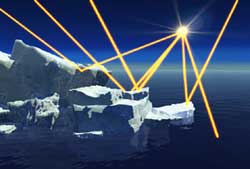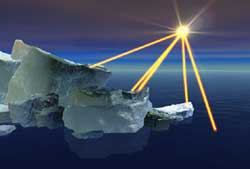30 June 2014
Cold War era samples reveal sharp drop in major global warming agent in part of Arctic
Posted by Nanci Bompey
By Nanci Bompey
Scientists measuring soot on thousands of air filters from the Finnish Arctic found a 78 percent decrease in the particulates — the second largest man-made contributor to global warming — from 1971 to 2010, according to a new study. However, remaining concentrations of this important global-warming influence in the same region are much larger than computer simulations had predicted they would be, the research also shows.
The filters used in the new research were originally collected by the Finnish Meteorological Institute to measure radioactivity from nuclear explosions in the former Soviet Union. “Fortunately, they didn’t throw [the filters] away,” said Liaquat Husain, an adjunct professor at the State University of New York in Albany, and the leader of the project.

 Conceptual animations showing how polar ice reflects light from the sun. As this ice begins to melt, less sunlight gets reflected into space. It is instead absorbed into the oceans and land, raising the overall temperature, and fueling further melting. Darker, soot-covered ice reflects less light as well, part of the warming effect (no audio). Click on either image to view animation.
Conceptual animations showing how polar ice reflects light from the sun. As this ice begins to melt, less sunlight gets reflected into space. It is instead absorbed into the oceans and land, raising the overall temperature, and fueling further melting. Darker, soot-covered ice reflects less light as well, part of the warming effect (no audio). Click on either image to view animation.
Credit: NASA
Scientists typically refer to soot as “black carbon,” which is emitted from the combustion of fuels and from biomass burning. The dark particles absorb heat from the sun; promote the formation of clouds, which can have a cooling or warming effect; and fall on the surface of snow and ice, promoting warming and melting.
Having a better idea of how much black-carbon concentrations have changed over the past decades will help scientists understand the effect of reducing emissions of these pollutants. It will also help them predict how black carbon will affect the climate in the coming decades, the study’s authors said.
The new research is the first to look at atmospheric black carbon measurements in the Finnish region of the Arctic. Its findings add to prior evidence that concentrations of these particles have been waning across the Arctic, according to the study’s authors.
The study relies on 2,280 weeks of data collected from 1964 to 2010. These comprise the longest direct measurements of black carbon anywhere in the Arctic, Husain and his colleagues reported this month in the Journal of Geophysical Research: Atmospheres, a publication of the American Geophysical Union. Another study published last year in JGR: Atmospheres, besides finding that black carbon is second only to carbon dioxide as a global-warming contributor, also concluded that the particulates’ influence on climate has been greatly underestimated.
The authors of the Finnish Arctic study have found that most of the soot in Kevo, which is located 350 kilometers (217 miles) north of the Arctic Circle and in an area where black carbon concentrations are higher than in other parts of the Arctic, came from the former Soviet Union and Europe. The decline in black carbon correlated with the collapse of the USSR, and reductions in fossil fuel and biomass burning in Europe, according to the study.
While the study’s authors said falling concentrations of soot in the Finnish Arctic were expected from computer simulations, the new study shows that the amount of remaining soot is four times greater than those models had projected. The model projections extrapolate from information about how much fuel or biomass is being burned, according to the study.
The new research also found that approximately 40 percent of the black carbon was deposited during the winter – a trend not accounted for in current models.
“Certainly, we should be happy that the concentration has decreased, but the fact that black carbon has been deposited on the ice in the high Arctic is still a problem because it is already there and contributes to the ice melting,” said Vincent Dutkiewicz, an adjunct research associate at the State University of New York in Albany, and lead author of the new study. “It doesn’t really go away until the ice melts, but the impact should be decreasing.”
Having a large amount of data going back so many years gives scientists greater insight into the changing Arctic climate, said Joshua Schwarz, a scientist at the National Oceanic and Atmospheric Administration’s Earth System Research Laboratory in Boulder, Colorado. Schwarz was not involved in the new research. The longer records scientists have, the greater precision they can attain with models they are using to predict the future climate, he said. “The more you have, the stronger story you can make about the different regions,” Schwarz said.
Researchers at the State University of New York in Albany worked with scientists from Clarkson University, the Finnish Meteorological Institute in Helsinki, Finland, and from the Center for International Climate and Environmental Research in Oslo, Norway, to conduct the study. The scientists used optical instruments to measure the amount of black carbon on 4,560 filters that were collected weekly over 47 years.
Nanci Bompey is a public information specialist/writer in AGU’s public information office.


 GeoSpace is a blog on Earth and space science, managed by AGU’s Public Information staff. The blog features posts by AGU writers and guest contributors on all sorts of relevant science topics, but with a focus on new research and geo and space sciences-related stories that are currently in the news.
GeoSpace is a blog on Earth and space science, managed by AGU’s Public Information staff. The blog features posts by AGU writers and guest contributors on all sorts of relevant science topics, but with a focus on new research and geo and space sciences-related stories that are currently in the news.